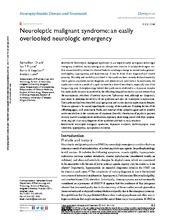Neuroleptic malignant syndrome: An easily overlooked neurologic emergency
Peer reviewed, Journal article
Published version

Åpne
Permanent lenke
https://hdl.handle.net/1956/17492Utgivelsesdato
2017-01-16Metadata
Vis full innførselSamlinger
Originalversjon
https://doi.org/10.2147/ndt.s118438Sammendrag
Neuroleptic malignant syndrome is an unpredictable iatrogenic neurologic emergency condition, mainly arising as an idiosyncratic reaction to antipsychotic agent use. It is characterized by distinctive clinical features including a change in mental status, generalized rigidity, hyperpyrexia, and dysautonomia. It can be lethal if not diagnosed and treated properly. Mortality and morbidity attributed to this syndrome have recently declined markedly due to greater awareness, earlier diagnosis, and intensive care intervention. In most cases, the syndrome occurs as a result of a rapid increase in a dose of neuroleptic, especially one of the long-acting ones. Pathophysiology behind this syndrome is attributed to a dopamine receptor blockade inside the neurons rendered by the offending drug and excessive calcium release from the sarcoplasmic reticulum of skeletal myocytes. Laboratory tests, although not diagnostic, may assist in assessing the severity of the syndrome and also the consequent complications. The syndrome has been described in all age groups and occurs more in males than in females. Genetics appears to be central regarding the etiology of the syndrome. Stopping the use of the offending agent, cold intravenous fluids, and removal of the causative agent and its possible active metabolites is the cornerstone of treatment. Periodic observation of psychotic patients recently started on antipsychotic medications, especially those being treated with depot preparations, may aid to an early diagnosis of the syndrome and lead to early treatment.
